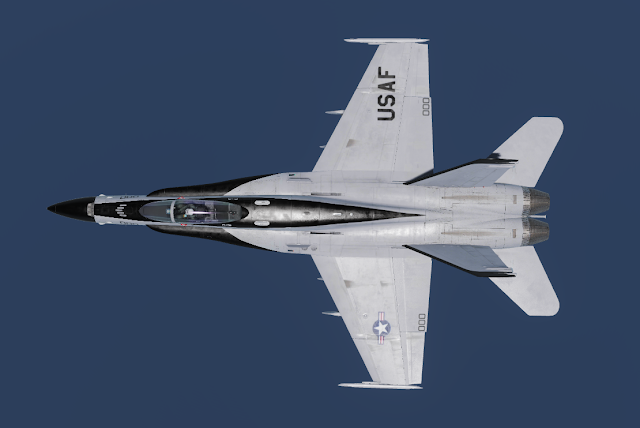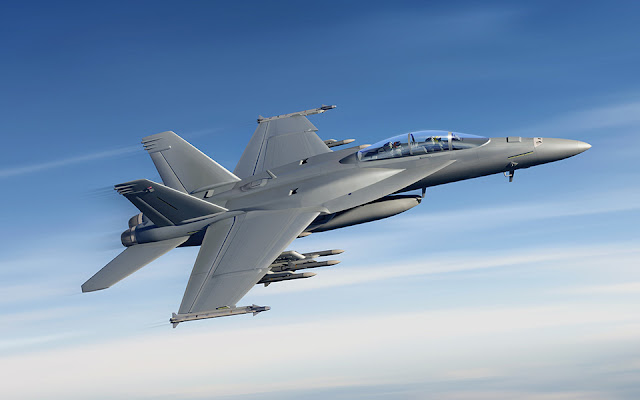The FA-18 Hornet is going to take the position of the F-14 Tomcat in this section. The F-14 Tomcat was previously used on aircraft carriers, but the FA-18 Hornet has since taken its place.

|
| Super Hornet F/A-18F |
The pilots of the United States Navy, Marine Corps, and Canadian Forces have done much more than only show the Hornet's combat worthiness, and the film Top Gun: Maverick's tremendous box office success has also garnered the Hornet a lot of attention from Hollywood moviegoers.
Originally developed as a fighter and ground attack aircraft, the FA-18 Hornet was a joint effort between McDonnell Douglas (now a branch of Boeing) and Northrop (now a division of Northrop Grumman). As a result, this versatile plane replaced not just one, not two, but three different types of older USN/USMC warbirds, including the Tomcat mentioned above as well as the A-6 Intruder and the A-7 Corsair 2. She had her maiden voyage on November 18, 1978, and resumed service on January 7, 1983.
F/A-18F Block III Super Hornet
During 1986's Operation El Dorado Canyon over Libya, the first-generation Hornet earned a superb reputation for its combat ability. After 1991's Operation Desert Storm, this fame would stick for much longer. For safety's sake, the Blue Angels have been flying around in the original Hornet.
The McDonnell Douglas/Boeing FA-18EF Super Hornet first flew on November 29, 1995, entered fleet service with the United States Navy in 1999, and was purchased by the Royal Australian Air Force (RAAF) in 2007 to replace the aging F-111C Aardvark fleet.
Now we can discuss the Block 3 Super Hornet, a product of Boeing's research and development division that was not happy to rest on its laurels. That's right, the Super Hornet is the Hardcore Hornet.
Block 3 provides the Navy with the most networked and resilient FA-18 created with a technology insertion plan that will outperform future threats, as boasted on Boeing's official information website.

|
|
F/A-18F Block III Super Hornet |
Given that the Super Hornet's Block 3 upgrades are superior to those of other 4th-generation fighters, it seems safe to assume that we can now classify it as a member of the 4.5-generation class. It is now conjecture whether or not the "future threats" part means being able to compete with antagonistic 5th-generation stealth aircraft like the Sukhoi Su-57 "Bandit."
The following upgrades are highlighted by Boeing: With Block 2 Infrared Search and Track (IRST), threats can be detected without the use of jammable radar. Other features include a reduced radar cross section (RCS), an advanced network infrastructure, open mission systems, so-called "conformal" fuel tanks with a 3,500 lb. capacity that offer lower drag and longer range, and a 10,000 hr. service life for the airframe. Alternatively, the Block 2 was only rated for 6,000 flight hours.
As of late September, Boeing had delivered the first of the 78 Block 3 airframes ordered by the US Navy.
How cool is the F/A-18 Super Hornet Block III?
Hornet to Super Hornet
The first FA-18 Hornet, designed and constructed by McDonnell Douglas, took to the air in 1978 and by 1984 had become the premier carrier fighter for the United States Navy. The Hornet was created to supplement the era's dogfighting dynamo, the F-14 Tomcat, and to replace a number of different carrier aircraft, such as the A-4 Skyhawk and F-4 Phantom 2. The Hornet is a notable platform for the Navy and the Marine Corps due to its multi-role design, which allows it to undertake a wide range of missions. This collection of abilities can be used in a variety of situations, and the F/A prefix indicates that.
By 1992, the U.S. Navy was ready to double down on the Hornet, but in order to stay up with the changing times, the aircraft needed a big facelift. To convince Congress that the program was a cost-effective derivative effort rather than a pricy clean-sheet design, the new Super Hornet was mainly a new aircraft that simply carried over the FA-18 nomenclature.
The transition from the Hornet to the Super Hornet, also known as Block I and Block 2 orders of this aircraft, was startling. The Block 2 Super Hornet, also known as the Rhino by its pilots, is larger than the original and features certain distinctive design elements that are easy to miss at first look but become immediately apparent when becoming familiar with both fighters.
The Super Hornet's range was increased by 33% thanks to the addition of 33% more fuel capacity and 15,000 more pounds of maximum weight. Changes were equally startling in the cockpit. A touchscreen monitor replaced the traditional keyboard, and new features like an Engine Fuel Display (EFD) and a Reference Standby Display were implemented (RSD). These screens, along with the rest of the cockpit, are now fully colored.
Various internal avionics, such as the radar, were also improved (the Super Hornet was equipped with an APG-79 radar system that could keep track of more enemy aircraft and spot them from much further distances). More AIM-120 missile stations, better radar warning receivers, an ALQ-214 jammer, and more chaff and flares than the Hornet could handle were installed to complement this enhanced air-to-air capability.
Marine Hornets were still stationed on American aircraft carriers as recently as February of this year, proving that the original Hornet was still a formidable fighter. The Hornet from Block 3 is the first fighter jet to enter the modern era.
The first two Block 3 Super Hornets, an E-model with a single pilot seat and an F-model with two, were delivered to the United States Navy in June for evaluation. When compared to the Block 2 variant of the plane, the new fighter has undergone considerable upgrades and design revisions across five main areas.
Rather than a plethora of instruments and readouts, the Super Hornet's Block 3 cockpit features a single touchscreen interface.
The purpose of simplifying these displays is to enhance data management, not to diminish the quantity of data available to pilots. Fighter pilots must receive data from multiple screens and their surroundings, then blend it all in their heads to generate a thorough view of the battlespace they are in.
Block 3 Super Hornets are expected to bridge the gap between fourth-generation jets like the Super Hornet and computational powerhouses like the F-35, which makes this procedure easier for pilots. Each time you enter the cockpit, you can make new adjustments to the way your displays look.
Conforming Fuel Tanks
One of the most significant concerns confronting the United States Navy in the twenty-first century is a lack of fuel range in its carrier-based planes. Neither the present Block 2 Super Hornet nor the cutting-edge F-35C Joint Strike Fighter has the range to fight Chinese targets without putting their carriers in the range of China's hypersonic anti-ship missiles. The development of the MQ-25 Stingray refueling drone for use aboard American aircraft carriers is one example of the many efforts being made to increase the range of these aircraft.
However, this problem has been fixed on the Block 3 Super Hornet with the addition of 3,500 pounds of fuel capacity in the form of conformal fuel tanks. These auxiliary tanks are called "conformal" because they adapt to the shape of the fighter's fuselage. While this will not be enough to compensate for the capability gap created by China's anti-ship missiles, it is an essential step in the right direction.
Connectivity Abilities
The Block 3 Super Hornet is designed with the future of data in mind, with to its Distributed Targeting Processor-Networked (DTP-N) mission computer and Tactical Targeting Network Technology (TTNT) data link. The DTP-N is 17 times more powerful than the current mission computer on board the Super Hornet, and thanks to its open architecture, it can receive software updates without requiring any hardware upgrades.
Like the "quarterback in the sky," the F-35 Joint Strike Fighter, all of that computing capacity is now available to the rest of the force in the region thanks to the TTNT data link.
More difficult to detect on radar
Even though the Block 3 Super Hornet has a lower radar cross section than previous versions, it was never designed to be a stealth fighter and is therefore not one. Although most of what has been done to make it harder to retain a weapons-grade lock on the new fighter has been kept secret, reports indicate a major increase in lowering detectability.
As with other less-than-perfect stealth jets, the intention may not be to totally dodge detection, but rather to postpone combat; the Block 3 Super Hornet will have a reduced radar cross-section, but this does not constitute it a "stealth" fighter. The Block 3 Super Hornet could be spotted by enemy fighters or surface-to-air missile platforms, but the aim is to delay the acquisition of a weapon's grade lock until the plane has a chance to leave or evade.
Four thousand more hours aloft
Each Block 2 Super Hornet in the US Navy has a maximum flight time of 6,000 hours, therefore it goes without saying that the previous two decades of combat activities in the Middle East and abroad have severely impacted maintenance schedules and aircraft availability. The Block 3 Super Hornet also has an increased service life of 10,000 hours, an increase of 4,000 hours from its predecessor.
While this is still significantly shorter than the F-15EX's 20,000-hour lifespan, it is an improvement over the 6,000-hour lifespans of both the current FA-18 and the F-35C.
The Navy will have more latitude in logistics planning and the new Block 3 Super Hornet will be a more cost-effective means of delivering air power than ever before due to its increased lifespan.
Boeing officials have hailed the installation of a centerline tank-mounted infrared search track system (IRST) in the Block 3 Super Hornet as "integral" to the fighter's performance, despite the fact that the IRST is not a "Block 3" enhancement.
The Sukhoi Su-57 and Chengdu J-20 of China and Russia, respectively, are two of the fifth-generation aircraft that this passive detection system is designed to track. Rather of broadcasting a signal through space, the IRST can search the horizon for radar-beating fighters by catching up on the infrared heat radiated by their jet engines.
As a result, the Block 3 Super Hornet, which lacks stealth technology, has a fighting chance against stealthy jets, as it may be able to identify them from a hundred miles away against the sky background.




